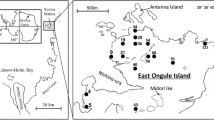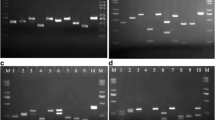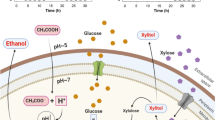Abstract
Acid-tolerant yeasts are one of the important keys to producing ethanol from acidic substrates, especially from molasses and agricultural waste. In this study, selected cultivars of yeasts isolated from a variety of locations such as botanical gardens in Thailand urban areas, which are often found highly polluted in the air such as carbon dioxide which is a cause of acid rain. There is limited information about how tolerant yeasts, are or their functional properties related to the environment. Yeast species were determined by using the 18S rDNA sequence guide. The level of acid tolerance was evaluated by adding to the culture medium lactic acid (300–900 mM), acetic acid (100–400 mM), and propionic acid (25–100 mM). 18S rDNA analysis has shown a %similarity of the nucleotide sequence higher than 98.65% compared to the database. Schwanniomyces etchellsii strains found in urban city soil were notable for their tolerance of lactic acid up to 100 mM. There are two main types of yeasts in overall acid tolerance: S. etchellsii, which is recognized as an osmotic pressure-resistant species that is highly resistant to fermentation inhibitors and produces ethanol; and Schizosaccharomyces pombe, which cell wall has been reported to be characterized by accumulation of α-(1,3)-glucan and malic acid can be used in metabolic pathways. The results show that S. pombe, isolated from rice paddy fields, can grow efficiently in acetic and propionic acid up to 400 mM and 100 mM, respectively. This species could be cultured in ethanol at a concentration of 12.5% (v/v). Moreover, it presented high ethanol and acetic acid production of 14.5–15.9 g/L and 7–10 g/L, respectively, with or without acidic conditions. In comparison, S. etchellsii, isolated from the botanical garden soil, which is grown in acetic, propionic, and lactic acid, was also indicated to be an organic acid-tolerant species.





Similar content being viewed by others
References
Ahmadi N, Khosravi-Darani K, Mortazavian AM (2017) An overview of biotechnological production of propionic acid: from upstream to downstream processes. Electron J Biotechnol 28:67–75
Arous F, Azabou S, Jaouani A, Zouari-Mechichi H, Nasri M, Mechichi T (2016a) Biosynthesis of single-cell biomass from olive mill wastewater by newly isolated yeasts. Environ Sci Pollut Res 23:6783–6792
Arous F, Mechichi T, Nasri M, Aggelis G (2016b) Fatty acid biosynthesis during the life cycle of Debaryomyces etchellsii. Microbiology 162:1080–1090
Badea GI, Radu GL (2018) Introductory chapter: carboxylic acids - key role in life sciences. In: Badea GI, Radu GL (eds) Carboxylic acid - key role in life sciences. IntechOpen, London, pp 1–5
Benito Á, Calderón F, Benito S (2017) The combined use of Schizosaccharomyces pombe and Lachancea thermotolerans-effect on the anthocyanin wine composition. Molecules 22:739
Biedunkiewicz A, Bielecki A (2010) Hirudo medicinalis Linnaeus, 1758–a probable vector of transmission of fungi potentially pathogenic for humans; initial studies. Pol J Environ Stud 19:43–47
Branduardi P, Dato L, Porro D (2014) Molecular tools and protocols for engineering the acid-tolerant yeast Zygosaccharomyces bailii as a potential cell factory. Yeast metabolic engineering. Humana Press, New York, pp 63–85
Carneiro CVG, Silva FCDPE, Almeida JR (2019) Xylitol production: identification and comparison of new producing yeasts. Microorganisms 7:484
Caspeta L, Nielsen J (2015) Thermotolerant yeast strains adapted by laboratory evolution show trade-off at ancestral temperatures and preadaptation to other stresses. Mbio 6:e00431
Chahardoli A, Jalilian F, Memariani Z, Farzaei MH, Shokoohinia Y (2020) Analysis of organic acids. In: Sanches SA, Nabavi SF, Saeedi M, Nabavi SM (eds) Recent Advances in Natural Products Analysis. Elsevier, Amsterdam, pp 767–823
Choi GW, Um HJ, Kim MN, Kim Y, Kang HW, Chung BW et al (2010) Isolation and characterization of ethanol-producing Schizosaccharomyces pombe CHFY0201. J Microbiol Biotechnol 20:828–834
Conte A, Speranza B, Sinigaglia M, Del Nobile MA (2007) Effect of lemon extract on foodborne microorganisms. J Food Prot 70:1896–1900
Gemmill TR, Trimble RB (1998) All pyruvylated galactose in Schizosaccharomyces pombe N-glycans is present in the terminal disaccharide, 4, 6-O-[(R)-(1-carboxyethylidine)]-Galβ 1, 3Galα1. Glycobiology 8:1087–1095
Guo ZP, Olsson L (2016) Physiological responses to acid stress by Saccharomyces cerevisiae when applying high initial cell density. FEMS Yeast Res 16:7
Halm M, Hornbaek T, Arneborg N, Sefa-Dedeh S, Jespersen L (2004) Lactic acid tolerance determined by measurement of intracellular pH of single cells of Candida krusei and Saccharomyces cerevisiae isolated from fermented maize dough. Int J Food Microbiol 94:97–103
Ji RY, Ding Y, Shi TQ, Lin L, Huang H, Gao Z et al (2018) Metabolic engineering of yeast for the production of 3-hydroxypropionic acid. Front Microbiol 9:2185
Jindamorakot S, Ninomiya S, Limtong S, Yongmanitchai W, Tuntirungkij M, Potacharoen W et al (2009) Three new species of bipolar budding yeasts of the genus Hanseniaspora and its anamorph Kloeckera isolated in Thailand. FEMS Yeast Res 9:1327–1337
Kildegaard KR, Jensen NB, Schneider K, Czarnotta E, Özdemir E, Klein T et al (2016) Engineering and systems-level analysis of Saccharomyces cerevisiae for production of 3-hydroxypropionic acid via malonyl-CoA reductase-dependent pathway. Microb Cell Factor 15:53
Koivistoinen OM, Kuivanen J, Barth D, Turkia H, Pitkänen JP, Penttilä M et al (2013) Glycolic acid production in the engineered yeasts Saccharomyces cerevisiae and Kluyveromyces lactis. Microb Cell Factories 12:82
Kuntiya A, Takenaka S, Seesuriyachan P (2013) High potential of thermotolerant Candida tropicalis no. 10 for high concentration of phenol biodegradation. Food Appl Biosci J 1:59–68
Lehmann DM, Krishnakumar K, Batres MA, Hakola-Parry A, Cokcetin N, Harry E et al (2019) A cost-effective colourimetric assay for quantifying hydrogen peroxide in honey. Access Microbiol 1:10
Li Y, Adams J, Shi Y, Wang H, He JS, Chu H (2017) Distinct soil microbial communities in habitats of differing soil water balance on the Tibetan Plateau. Sci Rep 7:46407
Lidén G (2017) Carboxylic acid production. Fermentation 3:46
Loira I, Morata A, Palomero F, González C, Suárez-Lepe JA (2018) Schizosaccharomyces pombe: a promising biotechnology for modulating wine composition. Fermentation 4:70
Loureiro V, Malfeito-Ferreira M (2003) Spoilage yeasts in the wine industry. Int J Food Microbiol 86:23–50
Lu C, Brauer MJ, Botstein D (2009) Slow growth induces heat-shock resistance in normal and respiratory-deficient yeast. Mol Biol Cell 20:891–903
Malainey ME (2011) Chapter 5: Organic Compounds. In: Malainey ME (ed) A Consumer’s Guide to Archaeological Science, Manuals in Archaeological Method, Theory and Technique. Springer, New York, pp 45–72
Martinez FAC, Balciunas EM, Salgado JM, González JMD, Converti A, de Souza Oliveira RP (2013) Lactic acid properties, applications and production: a review. Trends Food Sci Technol 30:70–83
Matsakas L, Topakas E, Christakopoulos P (2014) New trends in microbial production of 3-hydroxypropionic acid. Curr Biochem Eng 1:141–154
Merli G, Becci A, Amato A, Beolchini F (2021) Acetic acid bioproduction: the technological innovation change. Sci Total Environ 798:149292
Mira NP, Teixeira MC, Sá-Correia I (2010) Adaptive response and tolerance to weak acids in Saccharomyces cerevisiae: a genome-wide view. OMICS J Integr Biol 14:525–540
Ozaki A, Konishi R, Otomo C, Kishida M, Takayama S, Matsumoto T et al (2017) Metabolic engineering of Schizosaccharomyces pombe via CRISPR-Cas9 genome editing for lactic acid production from glucose and cellobiose. Metab Eng Commun 5:60–67
Petersen J, Russell P (2016) Growth and the environment of Schizosaccharomyces pombe. Cold Spring Harb Protoc. https://doi.org/10.1101/pdb.top079764
Phommachan K, Keo-oudone C, Nurcholis M, Vongvilaisak N, Chanhming M, Savanhnaly V et al (2022) Adaptive laboratory evolution for multistress tolerance, including fermentability at high glucose concentrations in thermotolerant Candida tropicalis. Energies 15:561
Phongprathet S, Vichitphan K, Han J, Vichitphan S, Swangkaew J (2018) Hanseniaspora thailandica BC9 β-glucosidase for the production of β-D-hexyl glucoside. J Microbiol Biotechnol 28:579–587
Relich RF, Schmitt BH, Koehlinger J, Wiederhold NP, May M (2015) Schwanniomyces etchellsii: an unusual cause of fungemia in a patient with cholecystitis. Diagn Microbiol Infect Dis 84:221–222
Ribeiro RA, Bourbon-Melo N, Sá-Correia I (2022) The cell wall and the response and tolerance to stresses of biotechnological relevance in yeasts. Front Microbiol 13:953479
Sauer M, Porro D, Mattanovich D, Branduardi P (2010) 16 Years research on lactic acid production with yeast-ready for the market. Biotechnol Genet Eng Rev 27:229–256
Song Z, Du H, Zhang M, Nie Y, Xu Y (2019) Schizosaccharomyces pombe can reduce acetic acid produced by Baijiu spontaneous fermentation microbiota. Microorganisms 7:606
Stanley D, Bandara A, Fraser S, Chambers PJ, Stanley GA (2010) The ethanol stress response and ethanol tolerance of Saccharomyces cerevisiae. J Appl Microbiol 109:13–24
Strassburg K, Walther D, Takahashi H, Kanaya S, Kopka J (2010) Dynamic transcriptional and metabolic responses in yeast adapting to temperature stress. OMICS J Integr Biol 14:249–259
Sun W, Vila-Santa A, Liu N, Prozorov T, Xie D, Faria NT, Ferreira FC, Mira NP, Shao Z (2020) Metabolic engineering of an acid-tolerant yeast strain Pichia kudriavzevii for itaconic acid production. Metab Eng Commun. https://doi.org/10.1016/j.mec.2020.e00124
Suyama A, Higuchi Y, Urushihara M, Maeda Y, Takegawa K (2017) Production of 3-hydroxypropionic acid via the malonyl-CoA pathway using recombinant fission yeast strains. J Biosci Bioeng 124:392–399
Takayama S, Ozaki A, Konishi R, Otomo C, Kishida M, Hirata Y (2018) Enhancing 3-hydroxypropionic acid production in combination with sugar supply engineering by cell surface-display and metabolic engineering of Schizosaccharomyces pombe. Microb Cell Factories 17:176
Thontowi A, Putra FJN, Yopi Y (2017) Evaluation of Non-Saccharomyces cerevisiae strains isolated from sea water against inhibitory compounds for ethanol production. Squalen Bull Mar Fish Postharvest Biotechnol 12:57–65
Tikka C, Osuru HP, Atluri N, Raghavulu PCV (2013) Isolation and characterization of ethanol tolerant yeast strains. Bioinformation 9:421–425
Walker GM, Stewart GG (2016) Saccharomyces cerevisiae in the production of fermented beverages. Beverages 2:30
Wallecha A, Mishra S (2003) Purification and characterization of two β-glucosidases from a thermo-tolerant yeast Pichia etchellsii. Biochim Biophys Acta - Proteins Proteom 1649:74–84
Warnecke T, Gill RT (2005) Organic acid toxicity, tolerance, and production in Escherichia coli biorefining applications. Microb Cell Factories 94:25
Yadav N, Hakkarainen M (2021) Degradable or not? Cellulose acetate as a model for complicated interplay between structure, environment and degradation. Chemosphere 265:128731
Zahoor F, Sooklim C, Songdech P, Duangpakdee O, Soontorngun N (2021) Selection of potential yeast probiotics and a cell factory for xylitol or acid production from honeybee samples. Metabolites 11:312
Zarnowski R, Sanchez H, Andreu C, Andes D, del Olmo M (2021) Formation and characterization of biofilms formed by salt-tolerant yeast strains in seawater-based growth medium. Appl Microbiol Biotechnol 105:2411–2426
Acknowledgements
This work was financially supported by Research and Researchers for Industries (RRI) by Thailand Research Fund [grant numbers PHD61I0031] and Innovation Institute, PTT Public Co. Ltd. Special Thanks for members of Biofuels by Biocatalysts Research Unit for support.
Funding
Research and Researchers for Industries (RRI) by Thailand Research Fund,PHD61I0031,PHD61I0031,PHD61I0031,Innovation Institute,PTT Public Co. Ltd.
Author information
Authors and Affiliations
Contributions
The authors confirm contribution to the paper as follows: All authors reviewed the results and approved the final version of the manuscript. Study conception and design: NB, CG Acquisition of data: SL, CG Analysis and interpretation of data: SL, NB, CG Drafting of manuscript: SL, CG Critical revision: CG.
Corresponding author
Ethics declarations
Competing interests
The author declare no competing interests. If material is not included in the article’s Creative Commons licence and your intended use is not permitted by statutory regulation or exceeds the permitted use, you will need to obtain permission directly from the copyright holder.
Additional information
Publisher's Note
Springer Nature remains neutral with regard to jurisdictional claims in published maps and institutional affiliations.
Rights and permissions
Springer Nature or its licensor (e.g. a society or other partner) holds exclusive rights to this article under a publishing agreement with the author(s) or other rightsholder(s); author self-archiving of the accepted manuscript version of this article is solely governed by the terms of such publishing agreement and applicable law.
About this article
Cite this article
Lertsriwong, S., Boonvitthya, N. & Glinwong, C. Schwanniomyces etchellsii, acid-thermotolerant yeasts from urban city soil. World J Microbiol Biotechnol 39, 159 (2023). https://doi.org/10.1007/s11274-023-03602-7
Received:
Accepted:
Published:
DOI: https://doi.org/10.1007/s11274-023-03602-7




